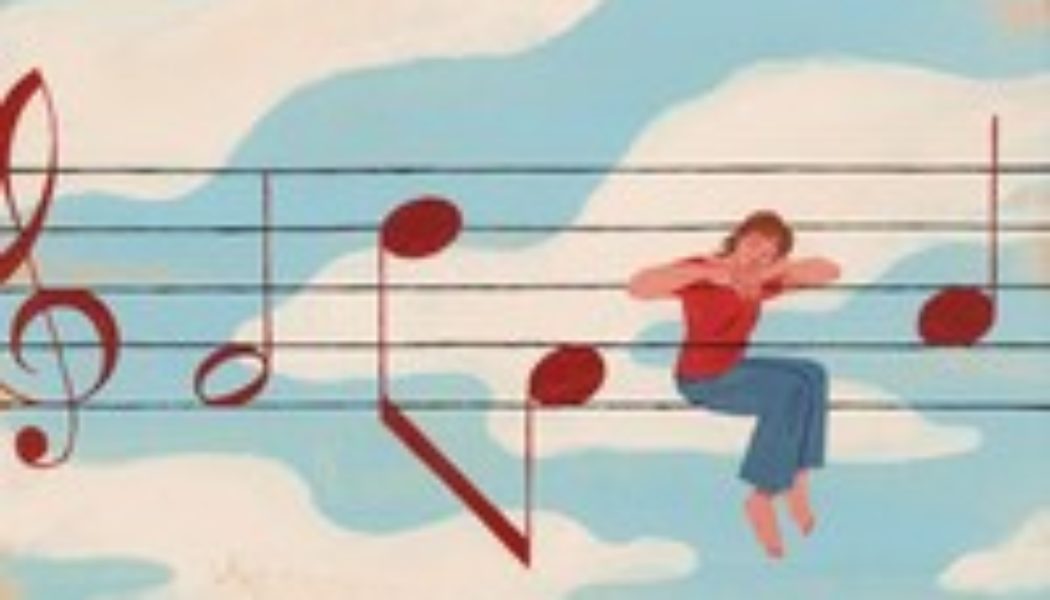
Music can have a profound effect on us. It can improve our physical and mental health by helping to reduce blood pressure, alleviate stress and lead to a release of dopamine, a neurotransmitter that affects our mood and sense of happiness, research shows.
As a music therapist working in a hospital, I use music to help reduce anxiety in patients. A review of 19 randomized controlled trials showed “an overall decrease in self-reported anxiety” among healthy individuals after listening to music, and a study I participated in found that a music therapy session resulted in positive outcomes for some patients.
I start with music that matches the patient’s frame of mind and slowly shift to more soothing themes. I find that their mood and affect will often follow. It’s called entrainment. We “entrain” to the music and follow along, both mentally and physically.
Listening or singing along to meaningful songs can also help people feel better.
I worked with a woman in her 40s who had been diagnosed with cancer. She was distressed because of the diagnosis, but there seemed to be another reason for her sadness that she could not put into words.
We spoke about music and her favorite meaningful songs. She mentioned that she loved listening to Fleetwood Mac, especially the song “Landslide.” I played and sang it for her. She cried and when the song concluded, she said, “I know why I’m so distressed. I’m worried about my children.”
The song, which features the words, “even children get older,” helped her to identify her concerns. We were then able to converse about her children and start to work on a plan for how she would tell them.
Music can speak for us
Sometimes, when we are gripped by panic and anxiety, we may not have the words to describe how we are feeling. Then, a song comes on the radio or our playlist, and it hits us: “That is exactly how I’m feeling!”
Music — whether the dark, minor essence of Beethoven or the down-tempo sparseness of Lucinda Williams — can speak for us, especially when we are feeling anxious or depressed. Susan Cain explores feelings of longing and melancholy in her book, “Bittersweet: How Sorrow and Longing Make Us Whole.” She theorizes that acknowledging and accepting these feelings make us whole and are comforting.
She references music as a way to help us navigate and own these feelings and says there’s power and a unique beauty in sad or melancholic music. “A moon-lit sonata can be therapeutic for people experiencing loss or depression; it can help us to accept negative emotions rather than ignoring or repressing them; it can show us that we’re not alone in our sorrows,” she writes.
Music is subjective
There are many articles with headlines such as “10 best songs to help you relax, according to science” or “30 songs to soothe you when you are anxious.”
What if you don’t like most or any of those songs?
One of the great things about music is that it is subjective and how we use it is personal, too. We can explore ways to use music, all kinds of music, to help us in our lives when we need it. There are times, particularly after an emotional day at work, when heavy rock music relaxes me. The sounds and aural atmosphere match my inner feelings and angst at that moment. It’s a release.
How I use music to help my patients
I generally use live music, improvised mainly on the guitar, to help people with pain and anxiety in a clinical setting. Live music helps me meet the patient where they are. I can then gradually change and manipulate the music to help bring them along to a more relaxed place. Sometimes, the patients fall asleep at the end of the music.
I have developed my music therapy technique over years of practice. These are the steps:
- The initiated soundscape is empathic; it reflects what the patient may be going through or feeling inside. The music is “entraining” to their inner psyche of the moment.
- The music may initially include some tension and dissonance.
- Then the music starts guiding them toward a new, more relaxed place. It has some release from the tension and more soothing and harmonic themes.
- It moves toward more resolve and grounding and focuses on aesthetics or beauty.
- Many times, the music concludes, having moved toward one chord — a simple two-note mantra.
How you can use music when you are anxious
When you are feeling anxious, instead of finding some “relaxing” music, put together a personal playlist and let the music or the song sequence guide you.
Start with a song or piece of music that matches your current mood. The initial song or songs can have a little more intensity, some tension and dissonance or melancholy. Then each ensuing song can gradually, one step at a time, help bring you along toward a more relaxed place.
Use music that you like. Maybe it’s Norah Jones or 80s pop or classic jazz or Mozart.
Here is a sample playlist with some instrumental guitar music, starting with a bit more intensity and then moving toward comfort and relaxation:
- “Prelude” — Alex de Grassi
- “Fusion of the Five Elements” — Michael Hedges
- “Megalopolis” — Rodrigo y Gabriela
- “The 2nd Law” — Michael Hedges
- “Sleeping Lady” — Alex de Grassi
- “The Sprinter” — Isato Nakagawa
- “Prelude in D Minor” — Acoustic Alchemy
- “Saint Agnes and the Burning Train” — Sting
- “A Child’s Song” — Will Ackerman
- “In This Moment” — Ken Verheecke
- “The Rain Is Pouring” — Alex de Grassi
- “For the Asking” — Will Ackerman
- “The Water Garden” — Alex de Grassi
- “The Bricklayer’s Beautiful Daughter” — Will Ackerman
- “Golden Slumbers” — Erik Söderlind
Music can meet us where we are — perhaps anxious, depressed or low — and help take us to where we want to be — calm and relaxed. Pick what moves you and make music work for you.
Raymond Leone, MMT, MT-BC, is the director of medical music therapy at A Place To Be and the Inova Health System. He also writes about music and wellness.
We welcome your comments on this column at OnYourMind@washpost.com.









